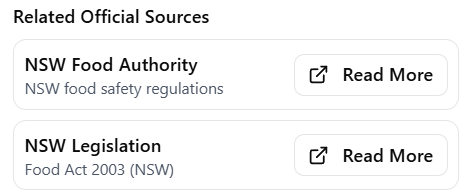Project Description
⚠️ IMPORTANT: The Navigator Module is located in the Navigator tab. Please ensure you are on that tab when visiting the website, and not the home page.
Motivation
Regulatory compliance can be a major barrier for businesses, especially small enterprises and entrepreneurs. Overlapping federal, state and local requirements, complex procedures, multiple permits and difficulty finding the right regulator are common pain-points. GovNav was built to address these frustrations. By combining open data with AI, the project aims to:
- Reduce the time and cost of figuring out which laws apply and when.
- Detect regulatory conflicts or duplication so users aren’t caught off-guard by contradictory obligations.
- Provide plain-English summaries of legal requirements, making compliance accessible to non-lawyers.
- Empower individuals and SMEs to engage confidently with Australia’s regulatory system, fostering innovation and economic growth.
Recent evidence highlights the scale of the problem: 82% of small businesses report that red tape has a major or moderate impact on their operations [1]. In NSW, a 2024 review found that while most firms spend under 10 hours per week on compliance, some businesses spend more than 50 hours per week, and some incur more than AUD $50,000 per year in compliance costs [2].
In short, GovNav (Navigator Module) is more than just a directory of rules. It is a smart navigator designed to simplify compliance, encourage civic participation and improve trust in regulatory institutions.
Problem Definition (Markdown “embed” alternative)
▶ Watch Presentation by Dr Paul Hubbard

Methods
How GovNav works
Regulation Finder
A guided, multi-step flow that collects your industry, location and planned activities, then queries official datasets to generate a tailored list of applicable Acts, legislative instruments and permits across jurisdictions.
Results & Checklist
After running the finder, GovNav produces an organised roadmap with progress tracking and plain-language summaries. The checklist spells out what to do, which regulator is responsible, and key timing/deadlines.
Interactive Visualisation
GovNav maps relationships between obligations to reveal overlaps and potential conflicts across federal, state and local levels. Users can explore how a Commonwealth requirement intersects with state rules or council permits.
Real-world examples
Worked scenarios (e.g., opening a food restaurant in NSW, launching a cybersecurity start-up in Canberra, managing residential construction in Brisbane) demonstrate how the navigator handles multi-jurisdiction compliance in different industries.
Every measure has been taken such that we comply (😆) with the Australian Government AI Technical Standard—ensuring the design, development, deployment, and use of AI systems are fair, transparent, accountable, and centered on public trust [4]. We also implement Amazon Bedrock Guardrails, including contextual grounding and Automated Reasoning checks to prevent AI hallucinations and ensure factual accuracy in outputs [5].
We also show transparency by clearly stating that our summaries are AI-Generated and by warning users to verify important information themselves.

To further support transparency, we provide additional related sources that users can consult:

References
[1] Australian Chamber of Commerce and Industry (ACCI), “Small businesses are still navigating red tape,” The Australian, Jan. 2025. 82\% of small businesses said regulatory burden had a significant impact [3]. News article.
[2] NSW Small Business Commission, Rightsizing Regulation – Final Report, Oct. 2024 – noted that while most respondents reported under 10 hours/week and under $5,000/year in compliance, some businesses reported more than 50 hours per week and more than AUD $50,000 per year in compliance costs (Charts 3 & 4) [turn0search1].
[3] Business Chamber Queensland, 2023 Efficient Regulation Report, Nov. 2023 – found 82% indicated costs associated with red tape increased since 2021, with median annual compliance cost doubling to AUD $50,000 [turn0search5].
[4] Digital Transformation Agency, Technical Standard for Government’s Use of Artificial Intelligence, Australian Government, 2025.
[5] A. Gupta et al., “Guardrails for Amazon Bedrock: detect hallucinations and safeguard generative AI,” AWS News Blog, Jul. 10 2024.




